SEBA Class 7 Maths Chapter 10 Practical Geometry Solutions | SCERT Assam
Get SEBA Class 7 Maths Chapter 10 Practical Geometry Solutions for Exercises 10.1, 10.2, 10.3, 10.4, and 10.5 in English Medium, following the SCERT Assam syllabus. This chapter covers basic construction methods, drawing geometric shapes with a compass and ruler, constructing triangles with given measurements, and bisecting angles and line segments. These step-by-step solutions will help students understand the concepts clearly and improve their problem-solving skills. Scan QR Code: A1B1B2 for quick access.
📚 Get Complete SEBA Class 7 Maths Solutions – Access step-by-step solutions for all chapters as per the SCERT Assam syllabus.
➡ Click here for full subject solutions
Practical Geometry
Exercise – 10.1 |
|---|
1. Draw a line m. Take a point ‘A’ which is not in the line m. Draw a line through ‘A’ which is parallel to m.
Ans:
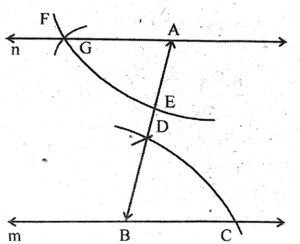
Steps of Construction:
1. A line ‘m’ is drawn.
2. Outside the line ‘m’, Point A is taken.
3. A point ‘B’ is taken on the line ‘m’.
4. Points A and B are joined.
5. With the point B as the centre, draw an arc and this are cuts the line ‘m’ at C and AB at D.
6. With the point C as centre another arc having same radius is drawn and this arc cuts AB at the point E.
7. With the point E an another arc having radius equal to CD and this arc cuts EF at G.
8. Now, A and G are joined and line ‘n’ is drawn which is the required line parallel to the line ‘m’.
2. Draw a line segment AB of length 10 cm. Draw another ray AX at point A such that ∠BAX = 60°, Take a point D on AX so that AD = 4 cm. Draw a line through point D which the parallel to the AB.
Ans:
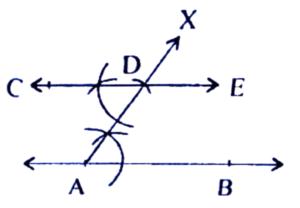
Steps of construction:
1. A line AB = 10 cm is drawn.
2. At the point A, a ray AX is drawn in such a way ∠BAX will be 60°. From the line AX, AD = 4cm part is cut out.
3. Now, at D, ∠EDA = 60° is drawn equal to the ∠BAX = 60°, ED is extended to C. CE line will be parallel to AB.
3. Draw a line PQ. Draw a perpendicular line at any point of PQ. Take a point R on the perpendicular line which is 5-6 cm away from PQ. Draw a line through R which is parallel to the PQ.
Ans:
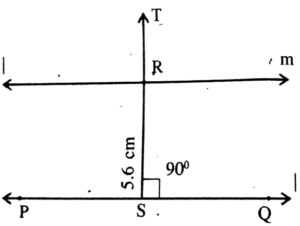
Steps of Construction:
1. PQ line is drawn.
2. A point ‘S’ is taken on the line PQ. Now, at the point S, ST perpendicular is drawn.
3. A point ‘R’ is taken at a distance of 5.6 cm from ‘S’.
4. Through the point ‘R’, a line segment ‘m’ is drawn in such a way that the line is perpendicular to ST. Now, the line ‘m’ will be parallel to PQ.
4. Draw a line segment XY of 7-5 cm. Draw two perpendicular lines of X and Y. Identify two points A and B in the perpendicular line which are 5 cm away from the XY. Through point A draw a line parallel to XY. Will this line pass through the point B?
Ans:
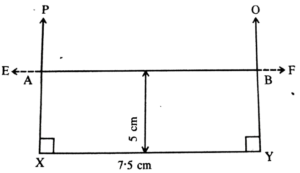
Steps of Construction:
1. A line XY measuring 7-5 cm is drawn.
2. At the points X and Y, two perpendiculars PX and QY are drawn.
3. On the two perpendiculars PX and QY, two points A and B are taken at a distance of 5 cm from the line XY.
4. Now, through the point A, EF line is drawn parallel to XY which passes through the point B.
Exercise – 10.2 |
|---|
1. Construct triangle ABC so taht–
(i) AB = 3 cm
BC = 4 cm
AC = 2.5 cm
Ans:
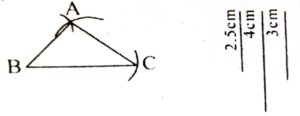
Let ABC be a triangle of which AB = 3 cm, BC = 4 cm and AC = 2.5 cm.
Step1: Draw a line BC of length 4 cm.
Step2: Considering B as centre an arc of radius 3 cm is drawn.
Step3: Again, Considering C as centre an arc of radius 2.5 is drawn. This arc intersects each other at A.
Step4: Now, A, B and A, C are joined. In this way the triangle ABC is constructed of which AB = 3 cm, BC = 4 cm and AC = 2.5 cm
(ii) AB = 6 cm
BC = 4 cm
AC = 7 cm
Ans:
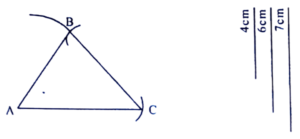
Let AB = 6 cm, BC = 4 cm, AC = 7cm of a ∆ABC.
Step1: Draw a line AC of length 7 cm.
Step2: Considering A as centre an arc of radius 6 cm is drawn.
Step3: Again, considering C as centre an arc of radius 4 cm is drawn. These two arc intersect each other at B.
Step4: BA and BC are joined.
Hence ∆ABC is a required triangle.
2. Construct an isosceles triangle base of which is 5 cm and two equal sides are of 4 cm.
Ans:
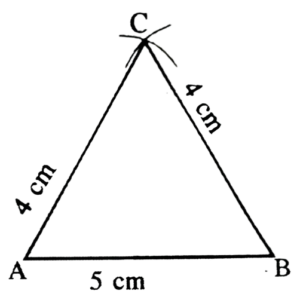
Steps of constructions:
Step1: Draw a line AB of length 5 cm.
Step2: Considering A as centre is drawn an arc of radius 4 cm. and again considering B as centre is drawn another arc of same radius. These two arc are intersected at C.
Step4: CA and CB are joined.
Hence ∆ABC is a required triangle.
3. Construct an equilateral ∆DEF of which DE = 6.5 cm.
Ans:
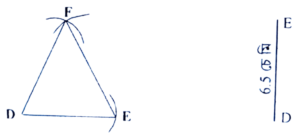
Steps of construction:
Step1: A line DE of length 6.5 cm is drawn.
Step2: Considering D as centre, an arc of radius 6.5 cm is drawn and another arc of same radius, considering E as the centre is drawn. These two arc are intersected at the point F.
Step3: FD and FE are joined.
Hence ∆FDE is the required triangle.
4. Construct the ∆XYZ of which XY = YZ = 5.5 em and XZ = 4 cm.
Ans:
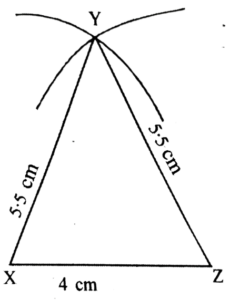
The triangle XYZ of which XY = YZ = 5.5 cm and XZ = 4 cm.
Steps of construction:
Step1: A line XZ of length 4 cm is drawn.
Step2: Considering X and Z as centres, two arcs each of radius 5.5 cm are drawn.
Step3: Two arcs are intersected each other at Y.
Step4: YX and YZ are joined.
Step5: Therefore, ∆XYZ is the required isosceles triangle.
Exercise- 10.3 |
|---|
1. Construct a ∆ABC of which AB = 6 cm, BC = 7 cm and ∠B = 75°.
Ans:

Let ∆ABC is a triangle of which AB = 6 cm, BC = 7 cm and ∠B = 75°. It is required to construct a triangle.
Steps of construction:
Step1: BC a line is drawn of length 7 cm.
Step2: A + B, ∠XBC = 75° is constructed.
Step3: Considering B as centre an arc of radius AB = 6 cm. is drawn which cuts BX at A.
Step4: Now, AB has joined. Hence, ∆ABC is the required triangle.
2. Construct a ∆PQR of which QR = PR = 8 cm and ∠R = 60°.
Ans:
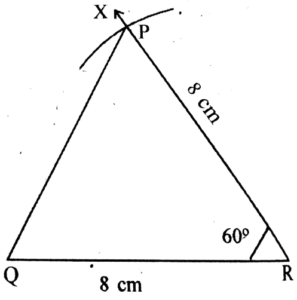
Steps of Construction:
Step1: QR a line is drawn of length 8 cm.
Step2: At the point R, RX is drawn in such a way it makes an angle measuring 60° with QR.
Step3: Considering R as centre an arc of radius 8 cm is drawn which cuts RX at P.
Step4: Join PR. Hence, ∆PQR is the required triangle.
3. Construct a ∆DEF of which DE = 5.5cm , DF = 7.5cm and angle D = 80°.
Ans:
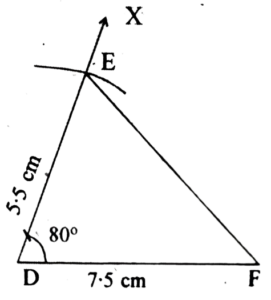
A triangle DEF of which DE = 5.5 cm., DF = 7.5 cm and ∠D = 80°. It is required to construct a triangle.
Steps of construction:
Step1: DF a line segment is drawn of length 7-5 cm.
Step2: At the point D, DX line is drawn in such a way that it makes ∠80° with DF.
Step3: Considering D as centre an arc of radius 5.5 cm is drawn which cuts DX at E.
Step4: EF is joined. Hence ∆DEF is the required triangle.
4. Construct a right angle triangle, the two perpendicular lines each of which is 4.5 cm.
Ans:
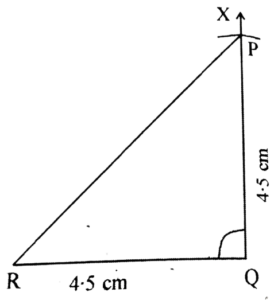
Steps of Construction:
Step1: A line segment QR = 4.5 cm is drawn.
Step2: At the point Q, QX 丄 QR is drawn.
Step3: Considering R as centre an arc of radius 4.5 cm is drawn which cuts QX at P.
Step4: PR is joined. Hence ∆PQR is the required triangle.
5. Construct a triangle of which two sides are 5.5 cm and 6.5 cm and the angle between two sides is 120°.
Ans:

Steps of Construction:
Step1: A line segment BC = 6.5 cm is drawn.
Step 2: Considering B as centre BX is drawn in such a way that it makes 120° with CB.
Step3: Considering B as centre an arc of radius 5.5 cm is drawn which cuts BX at A.
Step4: AC is joined. Hence ∆ABC is the required triangle.
Exercise – 10.4 |
|---|
1. Construct a ∆ABC of which ∠B = 65°, ∠C = 55°and BC = 7cm.
Ans:
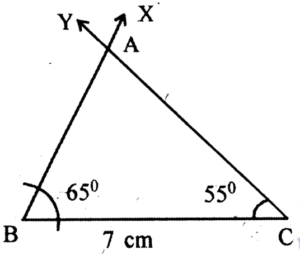
∆ΑBC of which ∠B = 65°, ∠C = 55° and BC = 7 cm. It is required to construct a triangle.
Steps of Construction:
Step1: A line segment BC = 7cm is drawn.
Step2: At B, ∠CBX = 65°and at C, ∠BCY = 55° are drawn. BX and CY rays are intersected at A. Finally, ∆ABC is constructed of which ∠B = 65°, ∠C = 55° and BC = 7cm.
2. Construct a triangle of which one side is 6.5 cm and the angles formed at two ends of the side are 45° and 75°.
Ans:
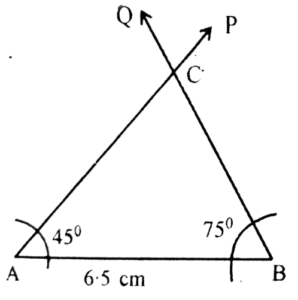
Steps of Construction:
Step1: A line AB = 6.5 cm is drawn.
Step2: At the point A, AP line is drawn in such a way that an angle of 45° with AB.
Step3: Again, at the point B, BQ line is drawn in such a way that an angle of 75° with BA.
Step4: Two lines AP and BQ intersect at C. Finally, ∆ABC is formed.
3. Construct a ∆PQR of which ∠P = 60°, ∠Q = 50° and QR = 6 cm.
Ans:
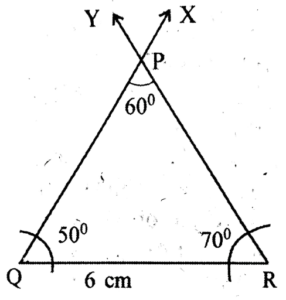
Steps of Construction:
Step1: A line segment QR = 6 cm is drawn.
Step2: At the point Q, QX is drawn in such a way, an angle of 50° is formed with QP.
Step3: At the point R, RY is drawn in such a way, an angle of 70° is formed with QR.
According to the property of sum of the angles of a triangle-
m ∠Q + m∠P = m ∠R = 180°
⇒ 50° + 60° + m ∠R = 180°
⇒ m ∠R = 180°- 110° = 70°
Step4: Two rays are intersected at P and finally ∆PQR is constructed.
4. Construct a ∆XYZ of which XZ = 5.5cm ∠X = 100° and ∠Z = 30°.
Ans:
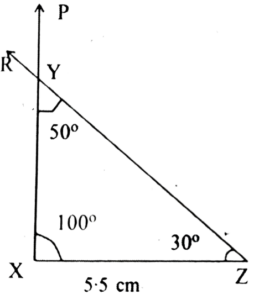
Steps of Construction:
Step1: A line segment XZ = 5.5 cm is drawn.
Step2: At the point X, XP ray is drawn in such a way that an angle of 100° with XZ.
Step3: Again, at the point Z, ZR ray is drawn in such a way an angle of 30° is formed with XZ.
Step4: Two rays XP and ZR are intersected of Y and finally ∆XYZ is constructed.
Exercise – 10.5 |
|---|
1. Construct ∆ABC of which ∠A = 90°, BC = 8 cm and AB = 5cm.
Ans:
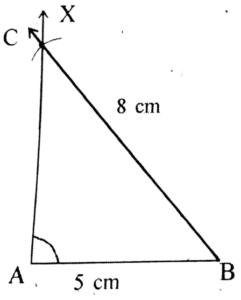
Steps of Construction:
Step1: A line segment AB = 5 cm is drawn.
Step2: At the point A, AX 丄 AB is drawn.
Step3: Considering B as centre an arc of radius 8 cm is drawn.
Step4: This arc cuts AX at C.
Step5: CB is joined and finally a ∆ABC is constructed.
2. The length of hypotenuse of a right-angled triangle is 10 cm and another side is 6 cm. Construct the triangle.
Ans:
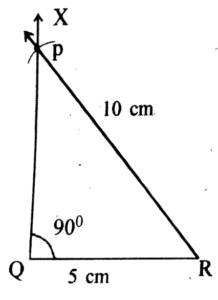
Steps of Construction:
Step1: A line segment QR = 6 cm is drawn.
Step2: At Q, QX 丄 QR is drawn.
Step3: Considering R as centre an arc of radius 10 cm is drawn.
Step4: This arc cuts QX at P.
Step5: PR is joined and finally ∆PQR is constructed.
3. Construct ∆PQR of which ∠Q = 90°, PR = 7.5 cm and PQ = 5 cm
Ans:
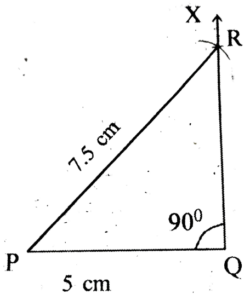
Steps of Construction:
Step1: A line segment PQ = 5 cm is drawn.
Step2: At the point Q, angle ∠POX = 90° is drawn.
Step3: Considering Q as centre an arc of radius 7.5 cm is drawn. This arc cuts QX at R.
Step4: R, P are joined. This is the ∆PQR constructed.
FAQS
-
1. What topics are covered in SEBA Class 7 Maths Chapter 10 Practical Geometry?
This chapter focuses on geometric constructions, including using a ruler and compass, drawing angles, bisecting line segments, constructing triangles, and understanding different geometric properties.
-
2. How many exercises are there in Chapter 10 Practical Geometry?
There are five exercises in this chapter: Exercise 10.1, Exercise 10.2, Exercise 10.3, Exercise 10.4, and Exercise 10.5, each covering different construction methods.
-
3. Are step-by-step solutions available for all exercises?
Yes, our solutions provide clear, step-by-step explanations for each exercise, making it easy for students to understand and practice geometric constructions.
-
4. Why is Practical Geometry important?
Practical Geometry is essential for engineering, architecture, designing, and understanding real-life applications of geometric constructions.
-
5. Are these solutions available in English Medium?
Yes, all solutions for SEBA Class 7 Maths Chapter 10 are provided in English Medium, based on the SCERT Assam syllabus.
